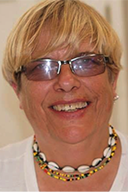The Early Childhood STEM Institute
By Peggy Ashbrook
Posted on 2017-04-01
 Guest blogger Cindy Hoisington is a Senior Curriculum/Instructional Design Associate with Education Development Center. Hoisington believes that authentic, cognitively challenging science experiences can be transformative for young children. She brings to her work more than 20 years of experience teaching young children, developing educational materials, and instructing and mentoring early childhood teachers in language, literacy, and science education. Welcome Cindy!
Guest blogger Cindy Hoisington is a Senior Curriculum/Instructional Design Associate with Education Development Center. Hoisington believes that authentic, cognitively challenging science experiences can be transformative for young children. She brings to her work more than 20 years of experience teaching young children, developing educational materials, and instructing and mentoring early childhood teachers in language, literacy, and science education. Welcome Cindy!
I was thrilled to have the opportunity to present at the Early Childhood STEM (science, technology, engineering, and math) Institute in Reno Nevada this week , an event sponsored by the Region 9 Head Start Association (covering the states of Arizona, California, Nevada, and Hawaii). This is Region 9’s sixth annual STEM institute and the theme was “Children as Inventors.” As a former Head Start (HS) teacher myself, it was wonderful to spend time with HS educators who fully appreciate the central role of exploration and play in children’s learning, an understanding that is fundamental to implementing rich, extended, and well-facilitated STEM experiences in classrooms. I presented on the topic of “Science and Language: A Natural Fit” and shared some of the work currently being done at Education Development Center Inc. (EDC) in Waltham MA. In our current project, Literacy and Academic Success for English Learners through Science (LASErS) , we build on a long stream of Early Childhood science work at EDC, and work with pre-K, K, and Grade 1 teachers in Hartford Connecticut to maximize science as a context for language and literacy development for ALL children. At my presentation, participants excitedly investigated mealworms (beetle larvae) and reflected on how this collaborative exploration promoted science thinking, language use, and the integration of challenging vocabulary. We viewed two videotaped science talks about ramps in preschool classroom to observe high quality teacher facilitation in action. Participants noted the tremendous respect the videotaped teachers had for children’s thinking and ideas about living things in one video, and about balls on ramps in another.

Cindy Hoisington leading a hands-on exploration of mealworm body structure.

Workshop participate Jill Uhlenburg observing mealworm motion.
At this Institute I also had the opportunity to participate on a panel discussion on the topic of “the future of math and science in early education” with STEM experts from WestEd, the University of Nevada, and Pacific Clinics Head Start. The discussion centered on challenges teachers face in facilitating STEM experiences along with potential solutions including: how to find time and space for doing their own inquiry-based investigations; how to integrate STEM and literacy goals; and how to maintain play at the center of children’s STEM experiences. These are universal issues that are important to early childhood teachers. Teachers at NSTA conferences express the same concerns.
A highpoint of the Institute for me was listening to the opening keynote by president-elect of NSTA, David Crowther, who is also a professor of science education at the University of Nevada, Reno. He emphasized NSTA’s increasing focus on STEM in the early years and the need for our youngest learners to have access to high-quality STEM experiences that promote inquiry-based investigation and scientific thinking. As a co-facilitator of the National Association for the Education of Young Children (NAEYC) Early Childhood Science Interest Forum (ECSIF), I was particularly excited to hear him mention the Position Statement on Early Childhood Science Education adopted by NSTA and endorsed by NAEYC. He also emphasized how collaboration between NAEYC and NSTA can benefit early childhood science educators, a priority that the ECSIF has been promoting for several years.

Worm project, from the class of HS teacher Liana Guloyan, Pacific Clinics Head Start/Early Head Start.
Of course another highpoint of the event was the opportunity to meet and talk with STEM colleagues and educators from around the country. These conversations ranged far and wide and included: developing criteria to help teachers choose evaluate the educational quality of STEM materials and resources; using digital tools to promote children’s story-telling; and looking for the common threads across the STEM disciplines (direct experiences and opportunities for exploring, thinking, and talking) that can help teachers move forward in the STEM teaching.
I wrapped up my time at the institute with a visit to the science and math curriculum fair presented by teachers at Pacific Clinics Head Start/Early Head Start, located in Pasadena, CA called a “Celebration of Teachers Teaching Teachers.” The fair highlighted visually and intellectually stimulating documentation describing a variety of STEM projects (worms, wind, building, butterflies) in photos, drawings, and children’s words.
Disclaimer: The views expressed in this blog post are those of the author(s) and do not necessarily reflect the official position of the National Science Teaching Association (NSTA).


